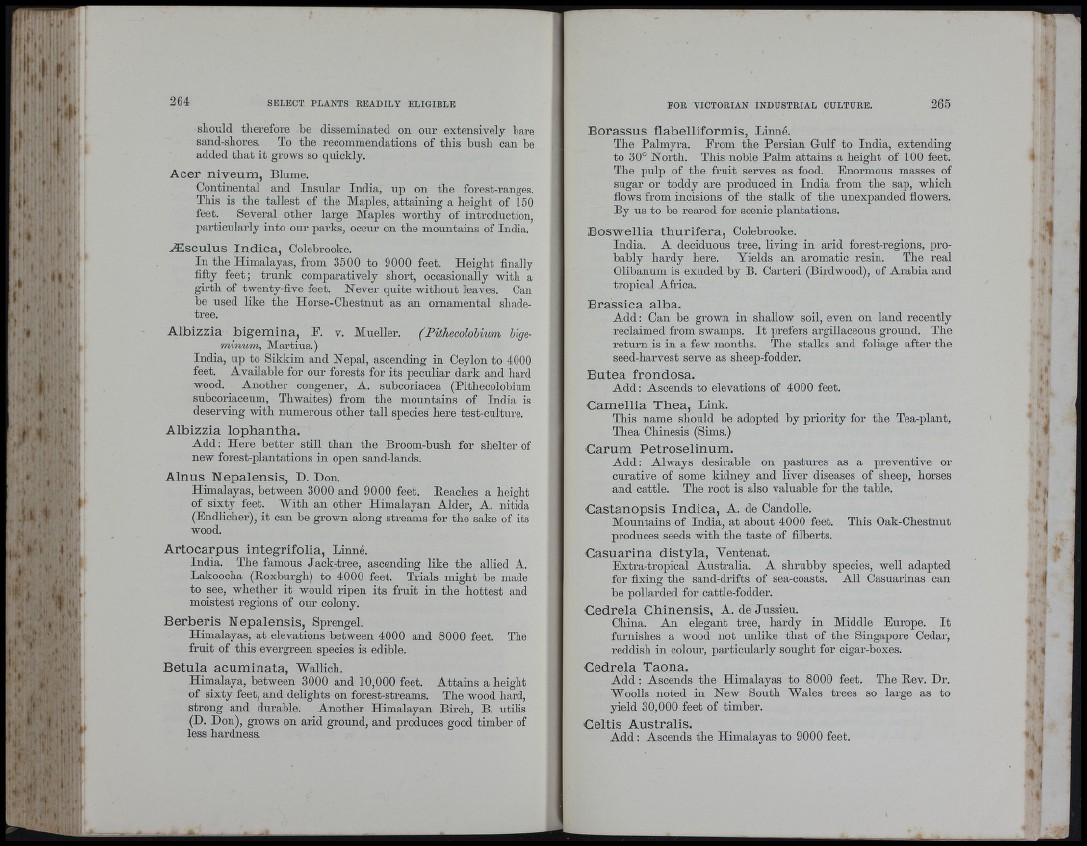
iI
» •
t
l
f i
'1 ; I
k
> «I
sliould tlierefore be disseminated on our extensively bare
sand-shores. To the recommendations of this bush can be
added that it grows so quickly.
Acer niveum, Blume.
Continental and Insular India, up on the forest-ranges.
This is the tallest of the Maples, attaining a height of 150
feet. Several other large Maples worthy of introduction,
jjarticularly into our pai’ks, occur on the mountains of India.
Æsculus Indica, Colebrooke.
In the Himalayas, from 3600 to 9000 feet. Height finally
fifty feet; trunk comparatively short, occasionally with a
girth of twenty-five feet. Never quite without leaves. Can
be used like the Horse-Chestnut as an ornamental shade-
tree.
Albizzia bigemina, F. v. Mueller. (Fithecolobiicm bige-
minurn, Martius.)
India, up to Sikkim and Nepal, ascending in Ceylon to 4000
feet. Available for our forests for its peculiar dark and hard
wood. Another congener, A. subcoriacea (Pithecolobium
subcoriaceum, Thwaites) from the mountains of India is
deserving with numerous other tall species here test-culture.
Albizzia lophantha.
Add: Here better still than the Broom-hush for shelter of
new forest-plantations in open sand-lands.
Alnus Nepalensis, D. Don.
Himalayas, between 3000 and 9000 feet. Beaches a height
of sixty feet. With an other Himalayan Alder, A. nitida
(Endlicher), it can be grown along streams for the sake of its
wood.
Artocarpus integrifolia, Linné.
India. The famous Jackitree, ascending like the allied A.
Lakoocha (Roxburgh) to 4000 feet. Trials might be made
to see, whether it would ripen its fruit in the hottest and
moistest regions of our colony.
Berberis Nepalensis, Sprengel.
Himalayas, at elevations between 4000 and 8000 feet. The
fruit of this evergreen species is edible.
Betula acuminata, Wallich.
Himalaya, between 3000 and 10,000 feet. Attains a height
of sixty feet, and delights on forest-streams. The wood hard,
strong and durable. Another Himalayan Birch, B. utilis
(D. Don), grows on arid ground, and produces good timber of
less hardness.
Borassus flabelliformis, Linné.
The Palmyra. From the Persian Gulf to India, extending
to 30° North. This noble Palm attains a height of 100 feet.
The pulp of the fruit serves as food. Enormous masses of
sugar or toddy are produced in India from the sap, which
flows from incisions of the stalk of the unexpanded flowers.
By us to be reared for scenic plantations.
Boswellia tburifera, Colebrooke.
India. A deciduous tree, living in arid forest-regions, probably
hardy here. Yields an aromatic resin. The real
Olibanum is exuded by B. Carteri (Birdwood), of Arabia and
tropical Africa.
Brassica alba.
Add: Can be grown in shallow soil, even on land recently
reclaimed from swamps. I t prefers argillaceous ground. The
return is in a few months. The stalks and foliage after the
seed-harvest serve as sheep-fodder.
Butea frondosa.
Add : Ascends to elevations of 4000 feet.
Camellia Tbea, Link.
This name should he adopted by priority for the Tea-plant,
Thea Chinesis (Sims.)
Carum Petroselinum.
Add: Always desirable on pastures as a preventive or
curative of some kidney and liver diseases of sheep, horses
and cattle. The root is also valuable for the table.
Castanopsis Indica, A. de Candolle.
Mountains of India, at about 4000 feet. This Oak-Chestnut
produces seeds with the taste of filberts.
Casuarina distyla, Yentenat.
Extra-tropical Anstralia. A shrubby species, well adapted
for fixing the sand-drifts of sea-coasts. All Casuarinas can
be pollarded for cattle-fodder.
Cedrela Cbinensis, A. de Jussieu.
China. An elegant tree, hardy in Middle Europe. I t
furnishes a wood not unlike that of the Singapore Cedar,
reddish in colour, particularly sought for cigar-boxes.
Cedrela Taona.
Add : Ascends the Himalayas to 8000 feet. The Rev. Dr.
Woolls noted in New South Wales trees so large as to
yield 30,000 feet of timber.
Celtis Australis.
Add : Ascends the Himalayas to 9000 feet.
I
d'.